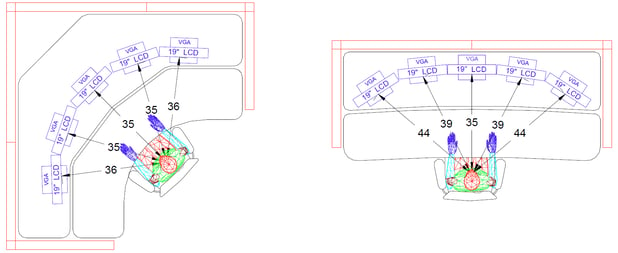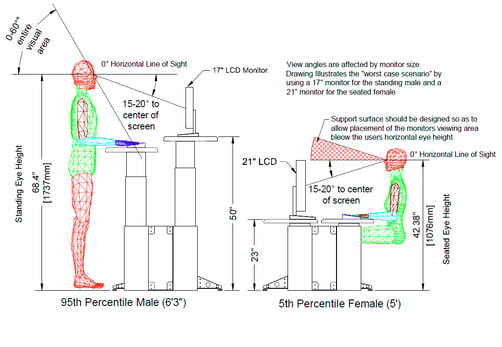 It is a known fact that the optimum monitor placement would locate users monitors equal distance from the user’s eyes in order to minimize the need for the eyes to refocus when looking from screen to screen, thus reducing eye strain.
It is a known fact that the optimum monitor placement would locate users monitors equal distance from the user’s eyes in order to minimize the need for the eyes to refocus when looking from screen to screen, thus reducing eye strain.
According to ANSI/HFES100-2007, the most comprehensive and up-to-date ergonomic guideline in the world, the minimum viewing distance should be 20 inches while the maximum viewing distance is 32.7 inches.
Hypothetically, let’s say a radiologist wants to accommodate five LCD monitors. The radiologist’s configuration is four diagnostic monitors and one RIS monitor. If the monitors are 19 inches wide and mounted on a dual-surface rectangular imaging desk, the monitor closest and straight ahead of the radiologist would be 9 inches closer that either of the two monitors on the far left or far right. This configuration would cause eye strain from re-focusing across the monitors; however, in the event the radiologist is using a curved imaging workstation, the cockpit workstation would allow for consistent focal lengths with only 1 inch difference in focal length between the center monitor and the furthest monitors left or right. The curved imaging desk would drastically reduce the opportunity for eye strain. (see illustration)
To further complicate matters, some radiologists view multiple modalities and require many monitors. Let’s consider a radiologist that wants to accommodate ten 19 inch LCD monitors. The ten 19 inch monitors can be placed on a cockpit desk with monitor focal length difference of 1 inch if the monitors are stacked. I am not an advocate of stacking monitors; however, in the event a radiologist is viewing multiple modalities and requires ten 19 inch monitors, the only option is to stack the monitors or have an desk of 190 inches in width. In this case, the radiologist would require binoculars to see the monitors furthest away, I certainly would not want them looking at my images. Currently, I have no knowledge of a height-adjustable imaging desk being 190 inches wide.
We have discussed monitor focal length; however, we haven’t mentioned monitor viewing angle requirements. Again ANSI/HFES100-2007 is the leading authority on the standard. The standard being the adjustment range of the monitor surface is that which is necessary to accomplish the required 15-20 degree view angles below horizontal eye level to the center of the screen for the 5th percentile seated female (21 inch) monitor to the 95th percentile standing male (17 inch monitor) user.
So to conclude, you can accommodate up to ten 19 inch LCD monitors on a Cockpit Corner Imaging Desk that would allow for the focal length adjustment of 10 inches on an movable monitor array, if the monitors are stacked and the desk is a true dual-surface sit to stand desk, with both the keyboard surface and the monitor surface moving independently from 23 inches to 50 inches.

With the correct ergonomic imaging desk, the multiple monitors required by radiologists can be accommodated and meet ANSI-HFES 100-2007 standards, allowing for comfort and good health.


